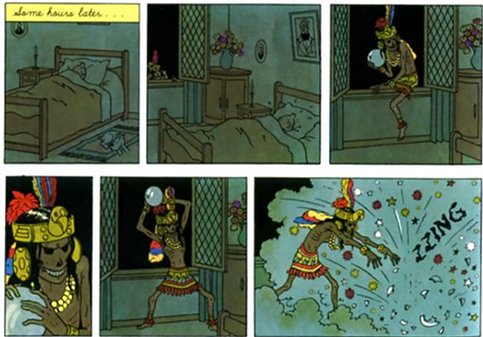Bert Stabler was talking over in another thread about imperialism, art, and taste and how the three interact. In that vein, I thought I’d reprint one of my favorite sequences from Tintin.
This is an avenging Inca Mummy, summoned by the conflation of ancient magic and the sacrilege of European explorers.
The moments I most like in Tintin are almost invariably the creepy, surreal ones. I find Herge’s humor repetitive and precious in general — and for me the clear line style only emphasizes the clean, scrubbed, antiseptic cuteness of the slapstick. The weird dream moments, on the other hand, are all the weirder for their pristine perfection. The clarity itself becomes frightening. In the second panel above from “The Seven Crystal Balls,” the Inca mummy’s face at the window, almost unnoticeable but still preternaturally distinct, seems more real than real, it’s perfect finish giving it an undeniability. Even though this is (sort of) only a dream, as it turns out, the dream looks as solid as the mundane window the mummy climbs thorugh. The fact that different content is presented so rigorously through the same form becomes in itself uncanny.
But what is the difference in form? Well, it’s pretty clearly racial difference. A lot of pulp narratives, from Sherlock Holmes to Fu Manchu, draw much of their spark from colonial fever dreams, and that’s certainly the case for Tintin as well. In “Seven Crystal Balls,” the Inca curse, and the mummy itself, are the parts of the story I remembered best from my childhood, and still find most compelling. They’re creepy and cool and unsettling, with an emotional depth that isn’t there, for me at least, in, say, the drawing room comedy of the Castafiore Emerald.
This, then, is really a case where I don’t like the sequence despite its racism and imperialism. As far as I can tell, I like it because of them. The fascination/repulsion Herge feels towards the strange gods of colonized cultures generates real creative frisson. Which makes me wonder if maybe that’s true of racism and stereotypes in general. It seems like, beyond their other uses, they sometimes have an appeal which might be called aesthetic. A certain amount of cultural creativity goes into shaping the person in front of you into a phantom monstrosity, and that creativity can itself be exciting and fascinating. The dream’s appeal is its vividly imagined ugliness; the exhilaration of imposing on the world the gothic products of one’s skull.

